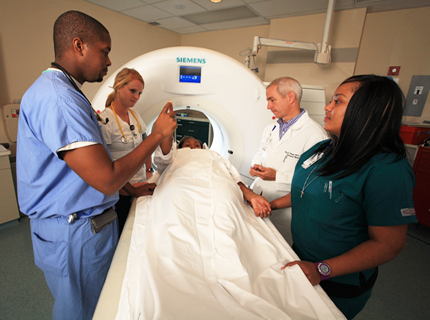Every second counts when it comes to treating ischemic stroke. Starting treatment promptly can save the life of a stroke victim or help minimize long-term brain injuries. That’s why the Barnes-Jewish & Washington University Stroke & Cerebrovascular Center has boosted stroke diagnosis and treatment times to world-class levels.
Stroke treatments are dependent on the type of stroke that is occurring: ischemic or hemorrhagic.
TPA for Ischemic Stroke Victims
tPA (tissue plasminogen activator) is a clot-busting drug that can significantly reduce long-term disability. tPA is the only FDA-approved thrombolytic drug for acute ischemic stroke, but it needs to be given to the stroke victim within the first 4.5 hours after a stroke occurs.
The Stroke & Cerebrovascular Center now has one of the fastest diagnosis-to-treatment times in the nation for tPA administration. Patients arriving at the Stroke & Cerebrovascular Center who are eligible for t-PA now receive it on average just 37 minutes after arrival. According to the American Stroke Association, the average for centers around the country is as high as 96 minutes.
Benefits of tPA include:
-
Less neurological damage
-
Faster recovery
-
Shorter in-hospital stay
tPA can be given by IV, usually through a vein in the arm, or injected directly to the site of the clot. This intra-arterial tPA procedure, a faster way to get tPA to the blockage, is performed by an interventional radiologist, neurosurgeon or neurologist who inserts a thin, flexible catheter into an artery and threads it to the blood clot in the brain. Intra-arterial therapy can be effective even up to 8 hours after the onset of symptoms, extending the potential treatment window.
When tPA can’t be used or stroke patients fail to respond to tPA treatment, the Stroke & Cerebrovascular Center offers additional stroke treatments, such as Stent retrievers (a tiny cork-screw shaped device that physicians can insert into a blood vessel to trap and remove the blood clot causing the stroke).
New and potentially more effective devices are constantly being tested and added to the stroke team’s treatment options.
Hemorrhagic Stroke Treatment
Every stroke patient is treated individually – no two aneurysms are the same, and each patient receives unique treatment based on their symptoms. While tPA works well for ischemic strokes, hemorrhagic strokes require a different approach. Our specialists treat hemorrhagic stroke patients with the most technically advanced treatments available:
-
Endovascular treatment uses a small catheter in the arteries of the brain to fix the aneurysm. There are several methods that are used, depending on the size and shape of the aneurysm.
-
Coiling: small soft coils are placed directly into the aneurysm to fill the space and prevent bleeding.
-
Stents: metal mesh tubes are placed in the artery across the entrance to the aneurysm. These can be used with coils or by themselves to divert flow away from the aneurysm. One new and unique type of stent is the Pipeline device. Barnes-Jewish and Washington University Stroke & Cerebrovascular Center participated in the clinical trials leading to FDA approval of this device. We are the only facility offering the Pipeline treatment for aneurysm.
-
Aneurysm clipping is a neurosurgical procedure to apply small metal clips around the aneurysm, reducing the size of the aneurysm and stopping the bleeding in the brain. Pipeline stent is used to treat large inoperable aneurysm.
The specialized critical care unit assigns a team to each stroke victim and supervises the progress to help improve overall outcome.

Investigational Therapies
Patients at the Stroke & Cerebrovascular Center also are given the opportunity to receive investigational drugs. Stroke research being done at the Neurology & Neurosurgery Center is looking into ways to extend that treatment window for strokes in the back of the brain.
Our healthcare team also participates in bimonthly stroke conferences presented by Washington University's Department of Neurology. Each conference presents the latest evidenced-based medical research with a focus on the care and prevention of stroke. This ongoing communication provides members the opportunity to constantly learn—and use—new treatment and care options for their stroke patients.
If you suspect stroke, call 9-1-1 to activate rapid response services and transport to a Stroke Network hospital.
To find out more about the Barnes-Jewish Hospital Stroke Center, call 855.925.0631.